
|
FEATool Multiphysics
v1.17.5
Finite Element Analysis Toolbox
|

|
FEATool Multiphysics
v1.17.5
Finite Element Analysis Toolbox
|
This is a benchmark and validation model for linear elasticity where an elliptical thick plate with a hole is subjected to a uniform pressure load of 106 MPa [1]. The outer surface is assumed to be constrained from expansion, in addition to the center line which is fixed in the z-direction. Symmetry is also utilized so that only a quarter of the geometry is modeled.

This model is available as an automated tutorial by selecting Model Examples and Tutorials... > Structural Mechanics > Stress Analysis of a Thick Plate from the File menu. Or alternatively, follow the step-by-step instructions below.
The elliptical shape can be constructed by first making two elliptical cylinders and subtracting the smaller inner one from the outer larger one.
0 0 0 into the center edit field.0.3 into the length edit field.3 into the axis edit field.Approximation of curved boundaries can be improved by increasing the polygon resolution of the geometry object. This however will lead to an increased time and cost for performing geometry object operations.
32 into the resolution edit field.An elliptical cylinder is easiest to create by scaling the unit cylinder.
2 1 1 into the Space separated string of coordinate scaling factors edit field.0 0 0 into the center edit field.0.3 into the length edit field.3 into the axis edit field.32 into the resolution edit field.3.25 2.75 1 into the Space separated string of coordinate scaling factors edit field.To decrease the time and cost of the simulation, symmetry is utilized so that only a quarter of the geometry has to be modeled. To do this create a block overlapping one of the quarters, the use the Intersect tool to keep the overlapping objects.
3.5 into the xmax edit field.3 into the ymax edit field.-0.1 into the zmin edit field.0.5 into the zmax edit field.Subtract the outer from inner cylinder, while intersecting the resulting object with the block. Note that the edges and dimensions of the inner cylinder and block are larger than required instead of parallel and in-line, for more robust geometry operations.
TF2 - TF1 & B1 into the Geometry Formula edit field.In order to create edges at z = 0, on which to impose boundary conditions, two parallel objects can be created by copying the first and offsetting it to the lower half plane.
0 0 -0.3 into the Space separated string of displacement lengths edit field.0.1 into the Subdomain Grid Size edit field.0.3 for the Poisson's ratio and 2.1e11 for the Modulus of elasticity.-1e6 for the load force in the negative z-direction.Also fix the x and y displacements on the outer boundaries.
Due to the symmetry the x-displacement should be fixed on boundaries 3 and 8.
And similarly the y-displacement should be fixed on boundaries 2 and 7.
Note that a small offset, such as +/-sqrt(eps) can sometimes be required to ensure the evaluation points are inside the domain.
2 into the Evaluation coordinates in x-direction edit field.0 into the Evaluation coordinates in y-direction edit field.0.3 into the Evaluation coordinates in z-direction edit field.The stress analysis of a thick plate structural mechanics model has now been completed and can be saved as a binary (.fea) model file, or exported as a programmable MATLAB m-script text file, or GUI script (.fes) file.
[1] Davies G, Fenner RT, Lewis RW. NAFEMS Background To Benchmarks. LE10 Thick plate - normal pressure, 1992.